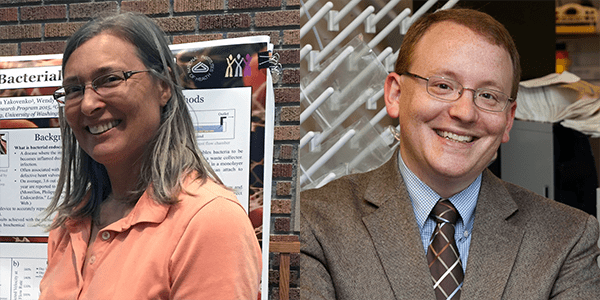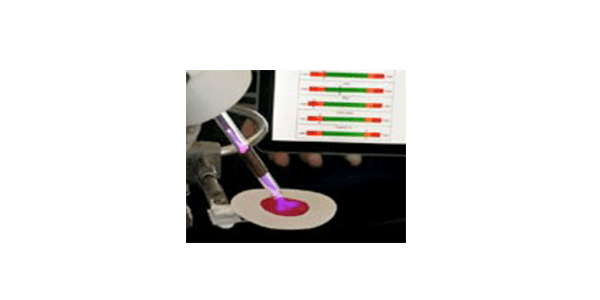Associate Dean, Academic Affairs, College of Engineering
Professor of Bioengineering
dratner@uw.edu
Phone: (206) 685-2840
Office: Foege N210D
Daniel M. Ratner
Label-free biosensors
Surface modification/characterization
Global health
Host-pathogen interactions
Drug development/delivery
Carbohydrates and glycoconjugates play an essential role in biology and medicine. Glycans are implicated in fertility, control many host-pathogen interactions (including influenza and gastroenteritis), serve as cancer antigens, and effect tumor metastasis. The Ratner laboratory is developing label-free glycoarray technologies to study carbohydrate-protein, carbohydrate-nucleic acid and carbohydrate-cell interactions with particular emphasis on the effects of surface chemistry, method of immobilization, density of attached glycan, and glycan accessibility on microarray performance. These tools will be used by the research community to improve our understanding of the biological roles of carbohydrates and aid in the development of novel drugs and treatments for cancer and infectious diseases.
Anti-adhesion Drugs
Pathogens, including protists, bacteria and viruses, are among humanity’s most significant and worthy adversaries. A great deal can be learned about fundamental biological processes by studying these supposedly simple organisms. Our lab is interested in developing new tools—based on label-free carbohydrate arrays—to study the roles played by glycans in mediating adhesion between pathogen and host. The ultimate goal of studying host-pathogen interactions is to design new means for disrupting pathogenesis.
Biomimetic Biomaterials: Nature has a great deal to offer when it comes to novel biomaterials. An especially remarkable material made by many pathogens is the cyst wall biopolymer, a natural stealth biomaterial. Many protozoan pathogens encyst to form a resilient and infectious cyst or spore, including Giardia, Entamoeba, Toxoplasma, Cryptosporidium, Acanthamoeba, Microsporidia, and Cyclospora. A mixture of carbohydrate and protein polymers, the cyst or oocyst wall protects the parasite during its passage between hosts, enabling the cell to resist bacterial degradation, shielding the cell from the hydrolytic environment of an animal’s digestive tract, and evading host immunity. Our lab is studying these biopolymers with an eye for designing materials based on their unique properties and composition.
Glycoproteomics
Carbohydrates can be used as molecular biomarkers, providing a window into cellular processes, wound healing, tissue differentiation, pathogen virulence and host-pathogen interactions. Utilizing mass spectrometry, the Ratner lab is identifying carbohydrate-modified proteins critical to infectious diseases—including malaria, giardiasis, trichomoniasis and amoebic dysentery. This research is being used to develop an understanding of enteric pathogens, to provide candidates for diagnostics and vaccine development, and to illuminate the molecular mechanisms of infection.
BA, chemistry, Pomona College, 1999
2012 Bioengineering Award for Outstanding Teacher/Mentor
2011 Wallace H. Coulter Translational Research Award
2010 NAE Frontiers of Engineering Education
2010 NAE U.S. Frontiers of Engineering (US FOE), UW Nominee
2010 Bioengineering Award for Outstanding Teacher/Mentor
2007 Recruitment Award, Washington Research Foundation
2004 Ruth L. Kirschstein NRSA Postdoctoral Fellowship, NIH
2002 Excellence in Teaching by a Graduate Student, MIT
2000 NIH Predoctoral Research Fellowship, Biotechnology Training Program, MIT
1999 Phi Beta Kappa, Pomona College
1999 Pomona College Scholar, Pomona College
1998 Nominated Associate Member of Sigma Xi, Pomona College
1995 Phi Beta Kappa Award for Top Graduating Senior, Shorewood High School
BIOE 497: Bioengineering Education Outreach
Ratner, D. M.; Cui, J.; Steffen, M.; Moore, L. L.; Robbins, P. W.; Samuelson, J. Changes in the N-Glycome, Glycoproteins with Asn-Linked Glycans, of Giardia lamblia with Differentiation from Trophozoites to Cysts. Eukaryotic Cell. 2008, 7, 1930.
Adams, E. W.; Ratner, D. M.; Seeberger, P. H.; Hacohen, N. Carbohydrate-Mediated Targeting of Antigen to Dendritic Cells Leads to Enhanced Presentation of Antigen to T Cells. ChemBioChem, 2008, 9, 294-303.
Ratner, D. M.; Seeberger, P. H. Carbohydrate Microarrays as Tools in HIV Glycobiology. Curr. Pharm. Design. 2007, 13, 173-183.
Ratner, D. M.; Murphy, E. R.; Jhunjhunwala, M.; Snyder, D. A.; Jensen, F. K.; Seeberger, P. H. Glycosylation as a Challenge for Microreactor-based Reaction Optimization in Organic Chemistry. Chem. Commun. 2005, 5, 578-580.
Ratner, D. M.; Adams, E. W.; Disney, M. D.; Seeberger, P. H. Tools for Glycomics: Mapping Interactions of Carbohydrates in Biological Systems. ChemBioChem, 2004, 5, 1375-1383.
Adams, E. W.; Ratner, D. M.; Bokesch, H. R.; McMahon, J. B.; O’Keefe, B. R.; Seeberger, P.H. Oligosaccharide and Glycoprotein Microarrays as Tools in HIV-Glycobiology: A Detailed Analysis of Glycan Dependent gp120 / Protein Interactions. Chem. Biol. 2004, 11, 875-881.
Ratner, D. M.; Adams, E. W.; Su, J.; O’Keefe, B. R.; Mrksich, M.; Seeberger, P. H. Probing Protein-Carbohydrate Interactions with Microarrays of Synthetic Oligosaccharides. ChemBioChem. 2004, 5, 379-383.
Adams, E. W.; Uberfeld, J.; Ratner, D. M.; O’Keefe, B. R.; Walt, D, R.; Seeberger, P. H. Encoded Fiber-Optic Microsphere Arrays for Probing Protein-Carbohydrate Interactions. Angew. Chem. Int. Ed. 2003, 42, 5317-5320.
In the News
Dan Ratner, Kim Woodrow Elected to AIMBE
2021-03-12T10:20:03-08:00February 15th, 2021|
BioE and ChemE faculty team receives College of Engineering Strategic Instruction Initiative award
2020-10-26T08:28:54-07:00September 12th, 2017|
Wendy Thomas, Daniel Ratner receive 2016 UW College of Engineering Awards
2020-10-26T08:29:58-07:00April 18th, 2016|
UW nanofabrication lab to receive $37M to expand work on tiny chips, sensors
2020-10-26T08:30:32-07:00August 3rd, 2015|
Rapid results lead the way in inventing the high-tech, low-cost future of medicine
2022-08-04T03:09:40-07:00February 14th, 2014|
Sticky paper offers cheap, easy solution for paper-based diagnostics
2020-10-26T08:32:06-07:00July 30th, 2013|










